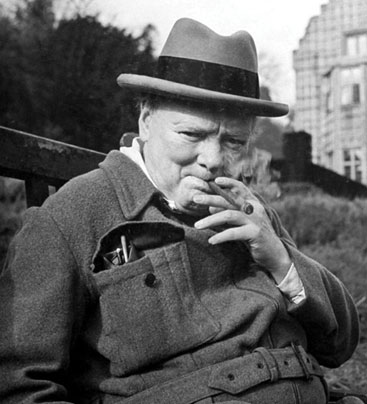FOR FREE TRADE

[1906]
(Cohen A18) (Woods A9)
The 1906 General Election was the first in which Churchill ran as a Liberal. He campaigned for Manchester North-West on a single issue: Free Trade, an institution dear to the hearts of the Manchester cotton manufacturers. Although the constituency had long been Tory, Free Trade had opened an opportunity for the Liberals who, unlike the Conservatives, were firmly committed to it. The Tories had split on the issue after their scion, Joseph Chamberlain, introduced his scheme of “Fair Trade,” which applied protective tariffs on goods from nations outside the British Empire. This was, of course, an anathema to the manufacturing community of Manchester—and to Churchill, who had been brought up in Lord Randolph’s house as a firm ally of Cobden and Bright, the Anti-Corn Law movement, and the knocking-down of tariffs in general. In that last great Liberal landslide, Churchill and his party were swept into office with 377 seats. Churchill had to fight for the seat again in 1908 when he was appointed to the Cabinet (as was then the custom). This time, he narrowly lost. Opponents passed out “Churchill Memory Cards” but they were premature; he was quickly offered and won Dundee, a seat he would hold for the next fifteen years through the worst upheavals and disasters of his career.
-Richard M. Langworth
From the Reviews
“Churchill objected to Protection as a policy that favored industry and monopoly at the expense of the small manufacturer, the consumer, and the shipping industry. It would cripple British exports, reduce the consumer market at home, raise prices, cause hardship to the poor, restrict enterprise, nurture vested interests, corrupt politicians, make the Empire odious to workers, worsen foreign relations and thereby raise defense spending. Its opposite, Free Trade, is the best foreign policy: it encourages international relations, interdependence and peace. He carried on the fight, as he saw it, against ‘corruption at home, aggression to cover it up abroad,’ against party tyranny, hollow patriotism, financial exploitation of the public interest by the private sector and the financial combines.
“All this sounds like radical rhetoric, and though it is used on behalf of the free play of forces in the capitalist economy, Churchill is not oblivious to the ‘sad conditions’ of the poor. He sets Free Trade as only a ‘negative process,’ a catalyst of progress but not progress itself. To defend Free Trade, an as-yet imperfect Britain must get at deep- seated ills by producing ‘a positive and practical policy of social reform.’ She had to think more ‘about the native toiler at the bottom of the mine and less about the fluctuations of the share market,’ to ‘consider the condition of a slum in an English city’ to be as important as a ‘jungle in Somaliland.’
“How right Churchill is in these speeches is a question best left to economists and is in any case dependent on the political philosophy of the reader. What should be noted is, once again, the masterly rhetoric, the excitement that these speeches on a dead issue can still generate. ‘Dead issue?’ The particular context is of interest only to historians, but the principles at stake are still around, albeit in reverse political order…In another land and a later time, For Free Trade is not without its relevance.”
—Manfred Weidhorn in the Preface to the American Edition, 1977
Comments
Along with Mr. Brodrick’s Army, this is the rarest Churchill title. In his Publisher’s Note to the First American Edition (1977), Dalton Newfield suggests that hardly more than a dozen copies of this volume exist.
Note: It is speculated that For Free Trade was a vanity press project published at Churchill’s expense by Humphreys, who was responsible for other such works, accounting for its scarcity. (See Glenn Horowitz in “Woods Corner,” Finest Hour 70, First Quarter 1991.)
Appraisal
Copies have lately changed hands for five-figure prices.
§ § §
Editions
 First Edition
First Edition
Cohen A18.1 / ICS A9a
Publisher: Arthur L. Humphreys, London 1906
Bound in red card wrappers with title, author’s name, publisher, date and price printed black and centered on front face; verso of front face and rear wrapper blank. 8vo, 136 pages numbered (i)-(xvi) and 1-119 (1). Published at 1 shilling (25c). No variations reported. Notably, the back wrapper advertises Mr. Brodrick’s Army (1903), which could not have sold well even considering the small press run. Contrary to bibliographer Frederick Woods, the typeface is 14-point, not 12-point Bodoni.
 American Edition
American Edition
Cohen A18.2 / ICS A9b
Publisher: The Churchilliana Company, Sacramento 1977
Hardbound, gilt stamped with title, author’s name and publisher’s logo on both cover and spine. Preceding the facsimile, reproduced photographically from a First Edition, are front matter, illustration (WSC addressing the Commons in 1906), a preface by Manfred Weidhorn and a publisher’s note by Dalton Newfield. The original text is sandwiched between replica red wrappers, printed black on front face. Endpapers reproduce Churchill’s entry in Who’s Who 1961-1970. Published in a half-brown cloth and half-cream buckram “collector’s binding” at $22.50 and a full-brown cloth “library binding” at $18.50. An outstanding service to the student, scholar, bibliophile and collector that continues to honor the memory of its late publisher, Newfield. Not in Woods.
§ § §
Click here for a list of terminology, bibliographic information, and other notes.


